Let’s explore the best tourist attractions in Stavanger:
The third-largest city in Norway, lively Stavanger is found on the country’s southwest coast, five hours’ journey south of Bergen. With roots dating back to the 12th century, it is one of Norway’s oldest villages. It has been a commercial hub for centuries and is now a well-liked cruise port since it is well-protected by offshore islands.
With music venues and yearly events like the MaiJazz Festival in May and the International Chamber Music Festival in August, the city is also a thriving center for culture.
There are a ton of interesting sites to see and enjoyable things to do in Stavanger if you include the city’s museums, which cover a wide range of topics from Vikings to offshore oil and everything in between, including sardines, airplanes, and seafaring. With numerous local lakes and a warm marine climate, the entire area is well-known as a recreational destination.
Check out our thorough list of the best Stavanger sightseeing opportunities and tourist attractions for further suggestions on how to organize your vacation itinerary to Norway.
1. Pulpit Rock (Preikestolen)
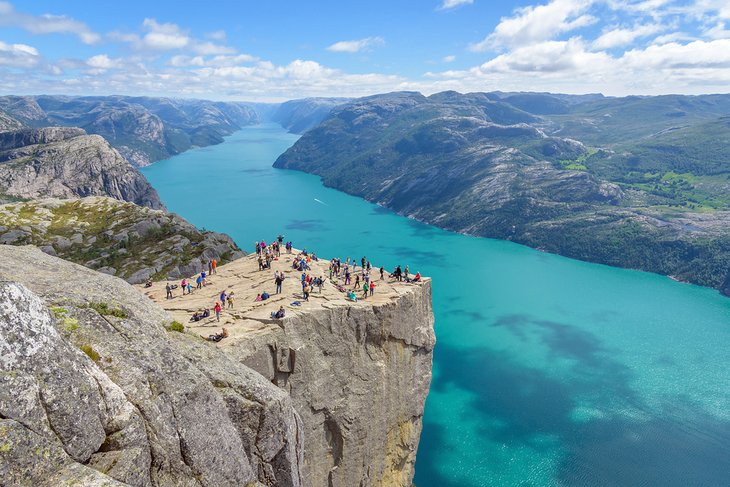
Unquestionably, the most well-known tourist destination in the Stavanger region is Pulpit Rock (Preikestolen). It’s one of Norway’s most recognizable images, too. One of the must-see sights in the nation, this gigantic flat-topped rock stands about 609 meters above the Lysefjord waters.
Preikestolen is a bit of a journey to get to, but it’s well worth it. The journey includes a bus, a four-hour roundtrip climb, and a ferry ride. However, the views from here on a clear day are amazing if you have decent walking shoes (the trail can be steep in spots) and a sense for heights (it’s a sheer drop from the edge).
Location: Rogaland, Norway
2. Norwegian Petroleum Museum
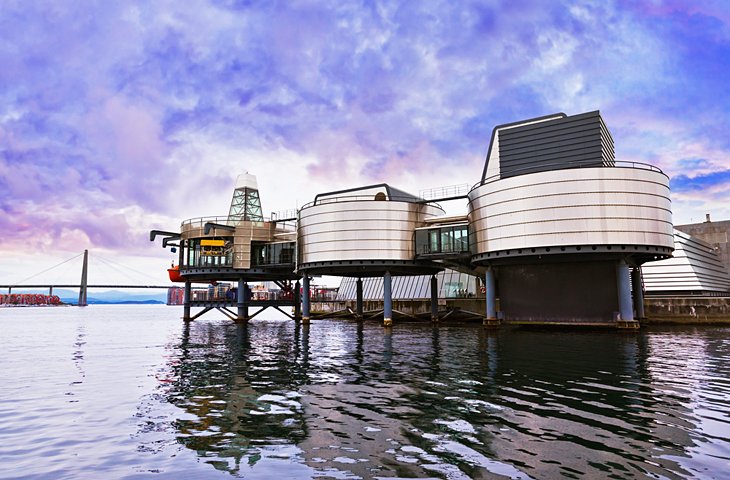
The Norwegian Petroleum Museum (Norsk Oljemuseum) combines science, technology, history, the environment, and social issues in an engaging way. Exploration of the geology of petroleum and the reasons why so much is found off the Norwegian Continental Shelf is done interactively. The process of donning a diving suit is enjoyable for adults, and there are other activities that are age-appropriate.
Address: Kjeringholmen 1A, 4006 Stavanger
3. Norwegian Canning Museum
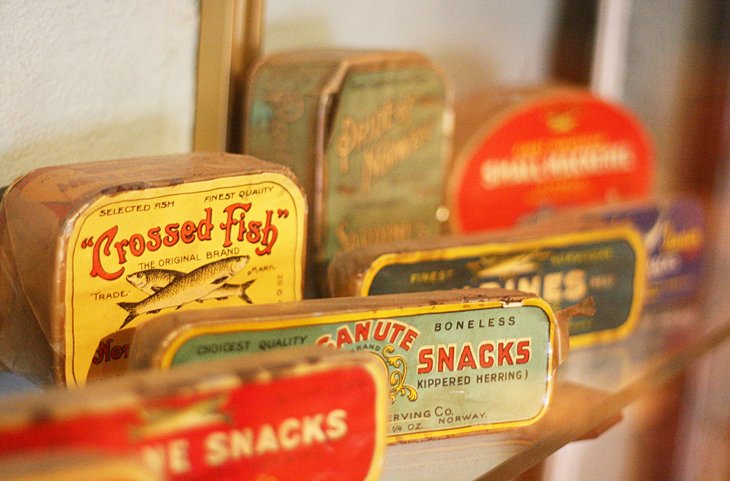
One of the roughly 70 canneries in Norway was the Venus Packing Co. in Stavanger. It has been brought back to its pre-World War I appearance. The museum displays the methods used to catch and process Norwegian sardines between 1879 and the mid-1950s.
Address: Ovre Strandgate 88, 4005 Stavanger
4. Stavanger Cathedral
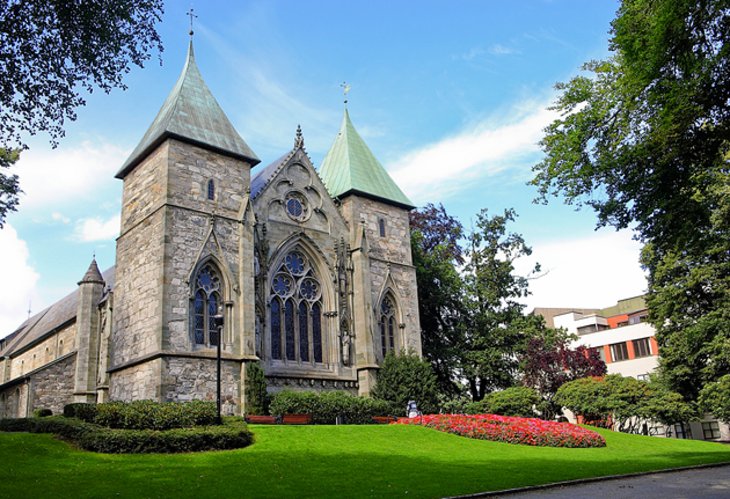
Designed as a three-aisle Romanesque basilica, Stavanger Cathedral was constructed in the 12th century. After a fire in the cathedral in 1272, the choir was rebuilt in the Gothic style. The Bishop’s Chapel, or Bispekapellet, which stands close by, was built in the early 1300s.
Address: Domkirkeplassen, 4001 Stavanger
5. The Valberg Tower (Valbergtarnet)
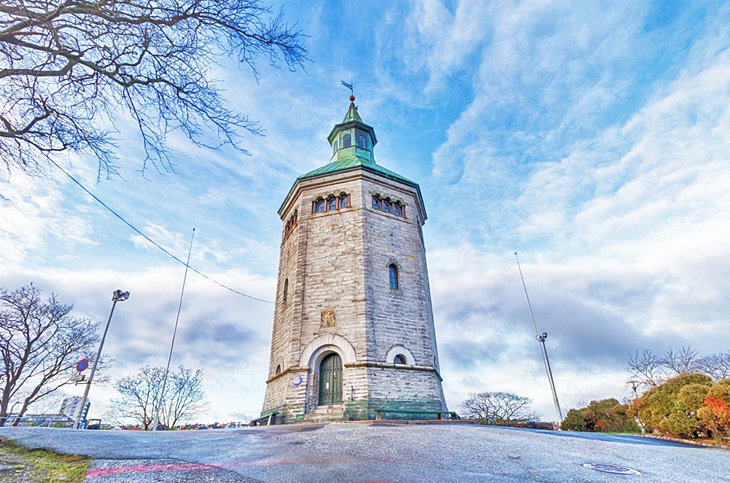
The Valberg Tower (Valbergtarnet), another of Stavanger’s older structures that has been maintained, is situated between Vagen and Ostre Havn to the north of Market Square (East Harbor). This former watchtower was constructed in 1853 on the highest point in the city and is situated in the Holmen peninsula, the town’s historical core.
It was the watchman’s residence, whose duty it was to inform everyone if a fire broke out. It now has wonderful views of the city and harbor in addition to the wonderful tiny Watchman’s Museum on the first floor.
Address: Valberget, 4001 Stavanger
6. Stavanger Museum
There are numerous museums within the Stavanger Museum. In actuality, the structure houses the well-known Norwegian Children’s Museum in addition to displays on natural and cultural heritage (Norsk Barnemuseum). It’s a fantastic one-stop shop that offers helpful background information on the city’s cultural origins, its flora and fauna, as well as the intriguing tale of how the sea has molded the town over the years (not to mention having somewhere for the kids to learn while having fun).
Generations of missionaries and seafarers from Stavanger have left behind a large portion of the museum’s collections after visiting far-off lands and bringing back priceless works of art. Along with artwork, home decor, clothing, and other relics of the city’s cultural legacy, these ethnographic collections are displayed in a variety of temporary exhibitions.
Address: Musegt. 16, N-4010 Stavanger
7. Gamle Stavanger (Old Stavanger)
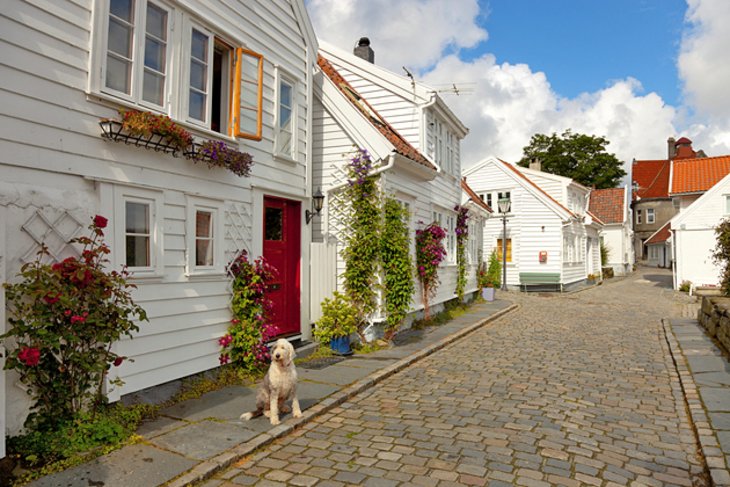
Gamle Stavanger is among the most scenic parts of the city. This ancient neighborhood is made up of a number of charming older houses that are arranged along winding streets with stone pavement. In reality, this is the largest village of wooden houses still standing in northern Europe.
The charming streets of Gamle Stavanger, as well as its art galleries and museums, are both worth investigating. The Norwegian Fish Canning Museum and the Maritime Museum are situated in this region, on Nedre Strandgate.
Address: Valberget, 4001 Stavanger
8. Stavanger Maritime Museum
The maritime sector has shaped Stavanger in numerous ways, from its early fishing fleets to its current role as a center for offshore petroleum. Stavanger has always been a city of seafarers. The Stavanger Maritime Museum (Stavanger Maritimt Museum), which traces the city’s business and industry from the herring fisheries and shipbuilding of the 1800s to its current status as Norway’s oil capital, contains a wealth of information about the city’s past.
The story is told in part by exquisitely detailed models of working boats and transatlantic liners, as well as by actual interiors and artifacts. A general store has been recreated using the interiors and goods of several demolished Stavanger shops that catered to seafarers, fishermen, and other town residents. The museum now houses a complete and original sail loft that was in operation here until the 1980s and includes all the sail-making tools.
A kid-friendly interactive exhibit called “Working at the Docks” portrays a harborside market. They can play and dress up here at market stalls, waterfront enterprises, and on a fjord boat.
Address: Strandkaien 22, 4005 Stavanger
9. Breidablikk Museum
Breidablikk, the family home of the Berentsens, is still largely the same as it was back in the 1880s. The Breidablikk museum’s highlights now include the opportunity to view authentic Victorian-era furniture, fabrics, chandeliers, porcelain stoves, trinkets, even flower arrangements, as well as a collection of works by leading Norwegian artists.
The 1950s dining room and library, as well as a bomb shelter the family erected in 1939, are just a few of the rooms in the home that feature furnishings from various periods when the home was inhabited. The magnificently maintained gardens, servants’ quarters, wash room, and barn with farm equipment and carriages are all accessible for viewing. The Ledaal, Holmeegenes, and Munkehagen historic gardens can all be reached by following this walk from here.
Address: Eiganesveien 40 A, Stavanger 4009
10. Lysefjord
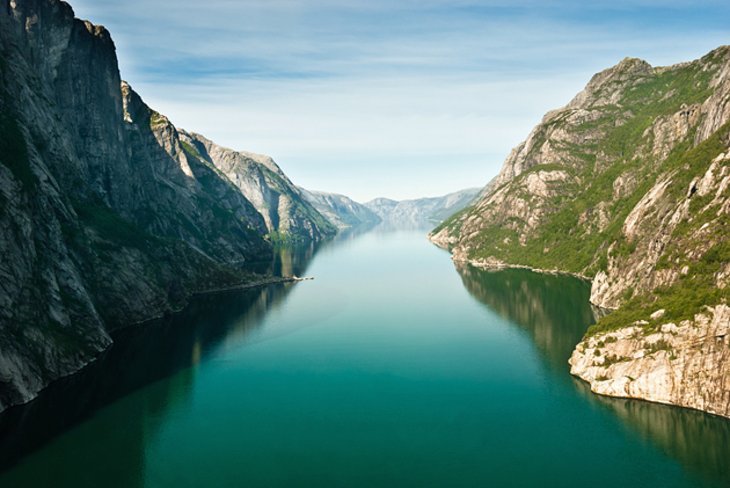
Lysefjord, a dramatic mountain rift up to 1.75 kilometers wide and 42 kilometers long that exposes stunning bright-green water, is located east of Stavanger. The sheer rock walls soaring 1,005 meters above the fjord are the cherry on top.
One of the best day outings in the area is this stunning environment. Fortunately, it’s accessible, and Stavanger makes it simple to arrange a variety of extremely nice boat journeys.
11. Ledaal House
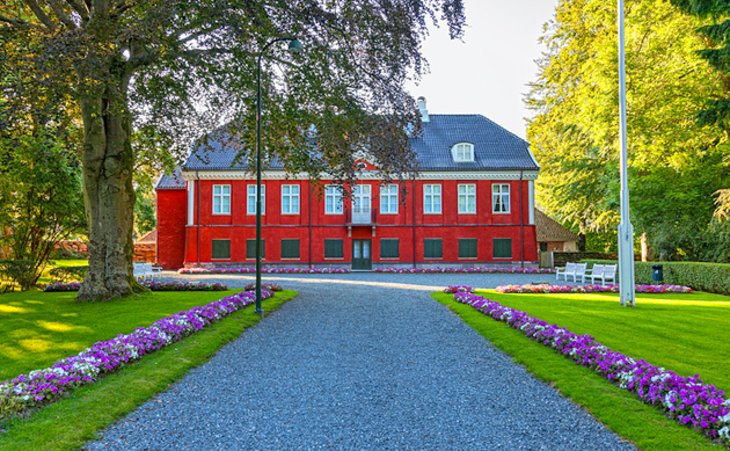
Ledaal House, constructed in 1799 as a vacation home for the Kielland family, is a wonderfully preserved illustration of how Norway’s aristocracy lived in the first half of the 19th century. The lavishly decorated palace continues to serve as a royal residence (it serves as both a museum and the King’s official residence in Stavanger).
The state holds title to the entire property in trust. Its historic gardens are excellent worth visiting, and a historic garden trail connects them to three other gardens.
Address: Eiganesveien 45, 4009 Stavanger
12. Museum of Archaeology
The Stavanger Museum of Archaeology is the best site to learn more about the Vikings while you are visiting Norway (Arkeologisk museum I Stavanger). The collections contain historical weaponry, equipment, and relics, as well as costumes and reproductions of Viking ships and boats.
However, the exhibit that may be the most visited here has nothing to do with Vikings. A 12,400-year-old skeleton of the fabled Finn, the Finnoy Polar Bear, was discovered in the town of Judaberg on Finnoy. The most comprehensive Ice Age polar bear from its era, it tells the interesting tale of Finn’s discovery and contrasts him with contemporary polar bears.
Address: Peder Klows Gate 30 A, 4010 Stavanger
13. Flyhistorisk Museum Sola
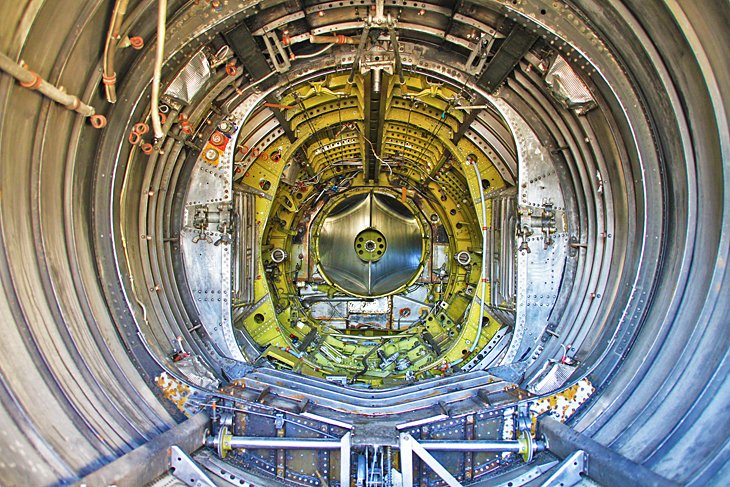
The Flyhistorisk Museum Sola collection features a variety of fully restored aircraft as well as aviation parts from World War II to the present, with a concentration on aircraft employed at the Sola military installation and Stavanger Airport. Its collection of more than 30 historic aircraft includes both military and civilian aircraft as well as uniforms, aviation models, and old pictures.
A unusual opportunity in an aviation museum is the ability to actually board some of the aircraft, and both English and Norwegian are used for the signage. The museum is close to the Stavanger airport at the seaplane port.
Address: Sola Prestegardsveg 170, 4050 Sola
14. Stavanger Art Museum
One of the best collections of Norwegian and foreign art may be seen at Stavanger Art Museum (Stavanger kunstmuseum), which is 3.2 kilometers from the city center in a lovely park surrounding Lake Mosvannet.
The singular collection of Lars Hertervig’s (1830–1902) paintings, whose lyrical and deeply intimate landscapes continue to captivate viewers, is of great importance.
Address: Henrik Ibsensgate 55, 4021 Stavanger
15. Utstein Abbey, Klosteroy
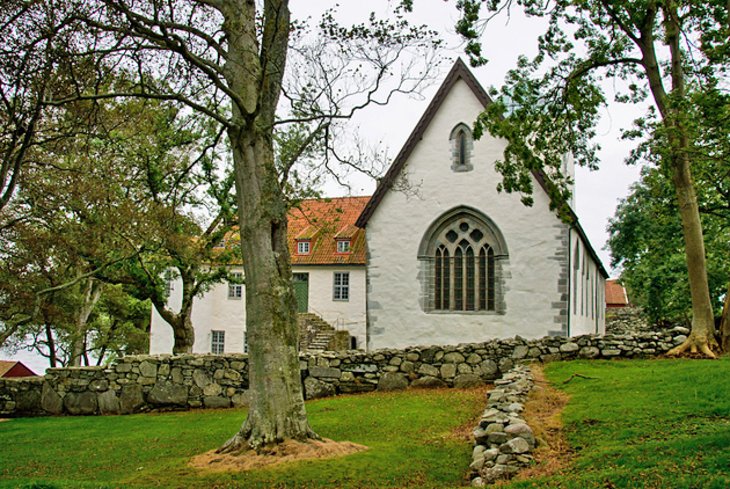
Numerous islands and islets can be found to the north of Stavanger, with the most well-known being the tiny Klosteroy. Klosteroy, which is connected by bridge to the bigger island of Mosteroy, is well-known for its Augustinian abbey, Utstein.
This well-preserved monastery house, which was first recorded in the 13th century, is accessible by boat from Stavanger.
Address: Mosteroyveien 80, 4156 Mosteroy
Where to Stay in Stavanger for Sightseeing
The best spot to stay in Stavanger is in the city center if it’s your first time coming. Stavanger Cathedral, the old town, and a number of museums are just a short stroll from one another at this location, making it easy to visit many of the key sites. Here are some recommended Stavanger lodgings in the neighborhood:
Luxury Hotels:A short stroll from the cathedral and the old town, the pet-friendly Clarion Hotel Stavanger offers cozy, modern rooms in addition to a top-floor Jacuzzi and sauna with views of the city.
The Scandic Royal Stavanger, a nearby hotel, offers luxurious accommodations with pillow menus, a spa, a fitness center, and the only hotel pool suitable for kids in the area.
The pet-friendly Scandic Stavanger Park is noted for its roomy suites with sitting areas and is conveniently located near the cathedral and Stavanger train station. It has a fitness facility and summer activities for kids. All these hotels include breakfast.
Mid-Range Hotels:
The stylish Comfort Hotel Square is in a great location, just a short stroll from the cathedral and the old town, and it offers vibrant, over-the-top artwork, inviting lounge areas, a gym, and a stunning rooftop terrace.
A two-minute walk from Stavanger Cathedral and the city center, the chic, dark-hued rooms at Thon Hotel Maritim, which is situated in a stunning lakeside location, come with complimentary breakfast.
A few blocks away, the Myhregaarden Hotel, located in a red-brick 19th-century structure, adds a touch of grandeur in some of the rooms with chandeliers and plush materials.
Budget Hotels:Although there aren’t many cheap hotels in Stavanger, you can get there by foot in around 10 minutes from the Stavanger lille Hotel. Basic hotel accommodations include TVs, refrigerators, and either communal or private restrooms.
Related:
15 Top-Rated Attractions In Tromso And Best Things To Do In Tromso
15 Top-Rated Attractions In Bergen And Best Things To Do in Bergen

